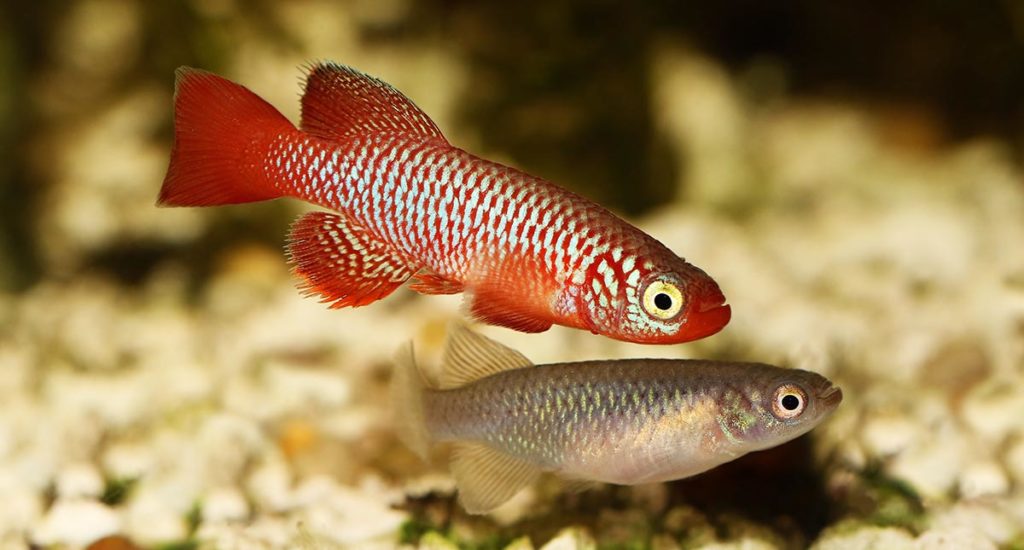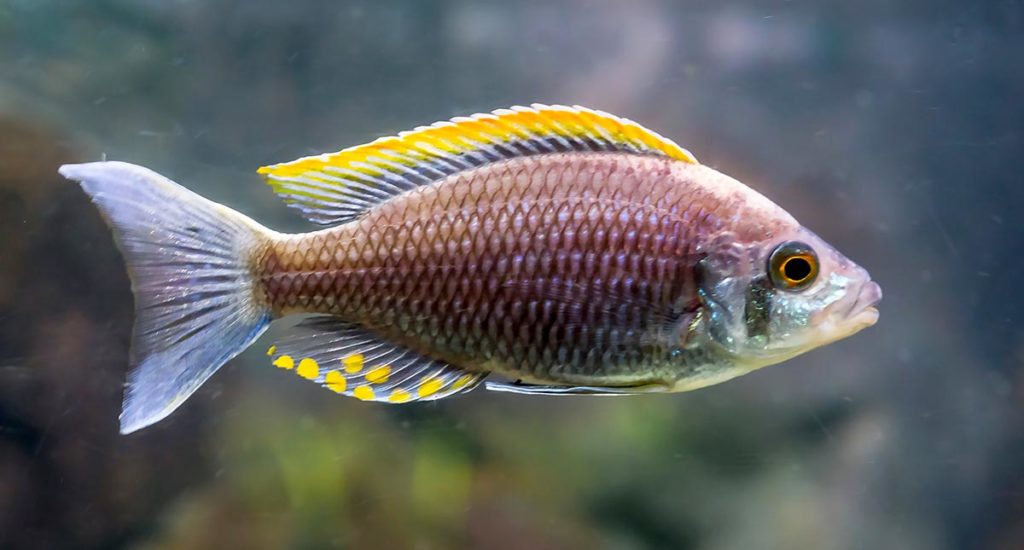
Kisaki Killifish, Nothobranchius flammicomantis, is included on the CARES Priority List, and classified as Vulnerable by the IUCN. While both authorities recognize the plight of this species, others are often overlooked. Image credit: Mirko Rosenau/Shutterstock
Assessing the Species in the CARES Preservation Program and the Role of Aquarium Hobbyists in Freshwater Fish Conservation was recently published in the open-access journal Fishes. Authors Jose W. Valdez of Aarhus University in Denmark, and Kapil Mandrekar of the SUNY College of Environmental Science and Forestry in New York, describe the necessity for hobby, science, and conservation entities to communicate and collaborate towards the common goal of freshwater fish conservation.
Before we dive into the essence of the paper, let’s first introduce and define both the IUCN and CARES.
IUCN
The IUCN (International Union for Conservation of Nature) is the world’s largest global environmental network that values and conserves nature. It harnesses the input from over 15,000 experts with the mission to encourage and aid societies worldwide to conserve the integrity and diversity of nature and to ensure the sustainable use of natural resources. The IUCN Red List of Threatened Species is a comprehensive source that places a species into one of nine categories based on its risk of extinction. The species status is determined after a thorough assessment by a group of experts in the field. Plants, animals, and fungi are all assessed by the IUCN.
CARES
The CARES (Conservation, Awareness, Recognition, Encouragement, and Support) preservation program is a fish conservation hobbyist organization that is comprised of 30 national and international societies and organizations. This program was first established in 2004 to encourage serious aquarists to help preserve vulnerable, endangered, or extinct-in-the-wild fish species by devoting tank space to house and breed species-at-risk as well as provide habitat, ecological, and husbandry knowledge to others. Independent of the IUCN red list, CARES has compiled a priority list of freshwater fish species that are considered to be at-risk.
Comparing the Two Programs
One could assume that the at-risk lists compiled by these two conservation groups would contain significant overlap. However, Valdez and Mandrekar found that there were significant discrepancies between the two. The CARES priority list contained 572 freshwater fish species, 30 of which were classified as extinct-in-the-wild. Cichlids represented nearly half of the CARES priority list followed by climbing gouramis, goodeids, loricariids, and poeciliids.
Interestingly only two-thirds of the CARES species were found in the IUCN red list. Among the species found on both lists, 64 species were classified differently between organizations where 7 species labeled as “least concern” by the IUCN were classified by CARES as extinct-in-the-wild. The IUCN plays a critical role in global species conservation and has classified over 2,500 species of freshwater fish as threatened, but none of the 29 loricariids listed by CARES was found on the IUCN red list. On the other hand, CARES classified less than 1% of characins, cobitiid loaches, and gobies listed as threatened by the IUCN. If both organizations serve the same purpose, why do these lists exhibit such differences?

Copadichromis sp. ‘Firecrest Mloto’ is believed to be extinct in the wild, a species surviving only in the aquarium trade, however as an undescribed species it has yet to be evaluated by the IUCN. Image credit: Charlotte Bleijenberg/Shutterstock
The vast number, not percentage, of species missing from the IUCN list but present on the CARES list are among the most popular fishes in the hobby. The authors explain that the overrepresentation of cichlids on the CARES list could be due to their popularity as an aquarium fish, but also due to the high endemism in habitats that are experiencing large anthropomorphic pressures. Loricariids are also wildly popular in the hobby but have not yet caught on in the scientific literature as many of these fish occur in locations difficult to access. Many of these armored catfish are not (yet) scientifically described and are designated with an “L-number” to differentiate between species. The hobby plays a critical role in freshwater fish conservation. The authors found that CARES lists over 80 species that are currently undescribed in the scientific literature.
Serious hobbyists and hobbyist organizations have extensive knowledge about many undescribed species including information on habitat, ecology, reproduction, and the general physical description. However, until a species is scientifically documented, it will most likely go under-the-radar of the IUCN. The authors of this paper call for a stronger partnership between major players in species preservation such as the scientific community, zoos and aquariums, and conservation organizations like the IUCN, and for these entities to turn to fish hobbyists and the reservoir of their untapped knowledge and to organizations such as CARES to help with the common goal of fish conservation.
Do you have tank space and the dedication to aid in the conservation of your favorite fish? To find out more information, check out the following links.
Additional Information
CARES preservation program: https://caresforfish.org
Current member organizations in the CARES program: https://caresforfish.org/?page_id=96
IUCN: https://www.iucn.org
IUCN red list: https://www.iucnredlist.org
Additional Reading
The hidden ark: How a grassroots initiative can help save fish from extinction: https://www.sciencedaily.com/releases/2019/10/191001083954.htm
Reference
Valdez, J.W. and K. Mandrekar. 2019. Assessing the species of the CARES Preservation Program and the role of aquarium hobbyists in freshwater fish conservation. Fishes 4(4), 49. https://doi.org/10.3390/fishes4040049






I’m interested in preserving a rare/endangered species of fish and feel my knowledge could be an asset put to good use….Do you have a fish that needs some husbandry from me….?